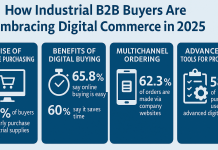Account-based marketing has seen a huge renaissance in recent years, and for good reason. ABM has traditionally demonstrated a greater ROI, increased success measuring capabilities, and stronger client retention. Companies that aren’t currently adopting an ABM approach are getting increasingly driven to do so as their competitors do.
To smooth the shift to an ABM approach, patience and attention are required. This collaborative sales and marketing strategy, on the other hand, fits in perfectly with the larger marketing trends of hyper-personalization and data-driven decision-making.
Here are five pointers for implementing an account-based marketing plan successfully.
Utilize Your Data
The core of account-based marketing is data collection and utilization. To begin, you will need data to establish which accounts have the greatest potential for a personalized approach and what specific problems you must tackle for your clients. Data may also help you understand a target customer’s main decision-makers, motives, and expectations.
Data is also the link that allows sales and marketing to collaborate to assess which targets have the most merit and create the most effective approach to securing the account. It is critical to recognize that both qualitative and quantitative data are important in ABM. Although hard figures and facts may help narrow down possible prospects, fine-tuning a sale requires a human touch.
Make Proactive Customer Service a priority.
Another emerging trend in B2B marketing is proactive client service. While it currently has a significant presence in SaaS marketing tactics and product-based B2C sales efforts, adopting proactive customer service approaches can aid in ABM’s success.
Because openness and authenticity are critical for ABM’s success, proactive customer service fits seamlessly into the broader approach. Companies that provide proactive customer service are open about obstacles and issues, frequently predicting problems and proposing remedies before they materialize.
The goal is to assist your customer before they realize they have a problem. Offering in-depth onboarding training and webinars to increase client adoption of a B2B software platform is one example.
Establish clear metrics and key performance indicators (KPIs).
One of the advantages of ABM, as previously stated, is the simplicity with which success criteria may be defined. Set specific goals and success criteria to monitor progress as you move through this process.
Consider the following critical metrics:
- Time to close (pipeline velocity)
- Account coverage
- Engagement and influence
- Retention and churn
- ROI
As you progress through this process, you may require more tools in your tech stack or professional assistance in data collection and analysis. You may also decide that dialogue is necessary to transform the obtained data into concrete improvement initiatives.
Create a Collaborative Workplace Culture
Despite operating in silos, sales and marketing teams have always had substantial overlap. While phrases like “synergy” have thankfully fallen out of favor, teamwork and support are essential for ABM’s success.
The development of a collaborative organizational culture is one of the most critical adjustments and long-term requirements for ABM. This entails breaking down boundaries between sales and marketing departments and ensuring that everyone is on the same page.
Top-down cultural change has a trickle-down influence. With the help of human resources, get leadership involved and proactive in supporting these changes. Create team alignment and concentrate on a common objective; with ABM, everyone wins.
Invest in Education
Changing procedures in a company is difficult. Many sales and marketing team members will be overwhelmed by the enhanced emphasis on proactive customer service and data-driven decision-making. Investing in training and skill development is the most effective strategy to overcome these obstacles and expedite the process.
To create good customer connections, account-based marketers and sales leaders must have empathy, active listening, and problem-solving soft skills. Providing advanced training for key participants in your plan can help you succeed.
Implementing an ABM strategy requires time and attention, but with three key focal points, your firm can transition smoothly.









